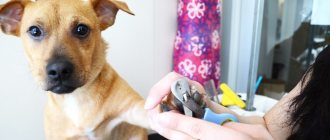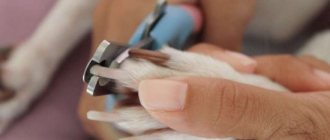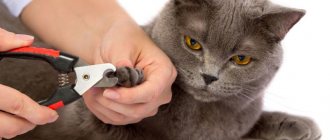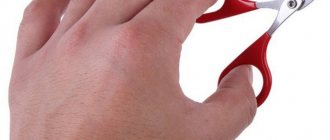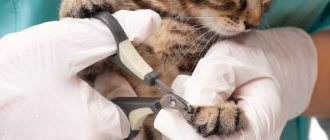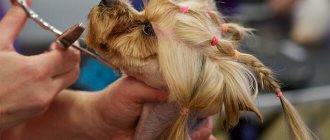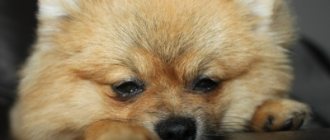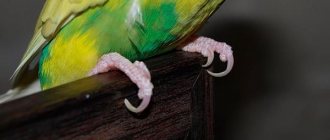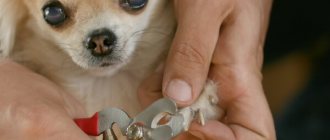Every dog breeder faces the question: how to trim a dog’s nails? Most often, people go to a veterinary clinic to carry out this procedure, however, if you follow all the rules, you can easily cut your pet’s nails at home. Many dog owners go to the veterinarian for the first time, and then ask to be shown how to trim them so that they can do it themselves at home. One visit to a specialist is enough to have an idea of how to do it yourself.
Is it possible and necessary?
Many people are interested in the question: Are dogs’ nails cut at all and is this really necessary for animals? Maybe you shouldn’t suffer yourself and bring discomfort to your beloved pet?
First, let's look at the anatomy and structure of dog claws. When describing breeds, standards usually indicate their shape. There are three in total:
- Cat - curved and with a curved tip,
- Bent - in the form of an arc,
- Hare - usually straight, long, and often sharp.
The first two types of claws are found in working dogs, and the third - in terriers and indoor toy breeds.
Dog claws have their own specifics: the hind paws have four claws and four toes, just like the front paws. Sometimes there is a fifth finger, but it is weaker than the others and its claw is not large. If a fifth claw appears on the hind legs, most dog lovers recommend removing it during childhood.
Does it hurt?
Many dog breeders do not want to trim their pet’s nails because... they think it hurts. So is it necessary to cut nails at all if the dog doesn’t like it?
The claws consist of a living and sensitive pulp, penetrated by nerves and blood vessels, and only on the outside are they covered with a keratinized membrane. But in fact, if you trim the nails correctly, without touching the living part, then the dog will not feel pain .
File
What's better, trimming your pet's nails or filing them? Despite the apparent advantages, the filing method has more disadvantages than advantages.
- It takes much longer.
- Filing can be much more stressful for your dog than nail trimming.
- This method is not suitable for all breeds.
- The nail file looks less dangerous than nail clippers. But it can also slip when filing and injure the dog’s paw.
In any case, trimming nails is preferable to filing . But a file is still needed: it is used to clean off the sharp edge formed when trimming the claw.
Instructions for owners
A dog's nails can be trimmed at home, but it is better to have the first procedure done by a professional and watch him work.
If the stratum corneum is shortened regularly, the inner part (pulp), filled with blood vessels and nerve endings, is shortened, and each subsequent procedure will bring less discomfort than the previous one.
Professional haircut
The procedure is carried out in veterinary clinics and grooming centers. Its cost does not exceed 200 rubles.
The first 2-3 procedures should be entrusted to a professional. During a haircut, it is important to take a closer look at how the groomer finds a common language with someone else’s pet, under what conditions the manipulation takes place, and what tool is convenient to work with.
At home they try to repeat everything down to the smallest detail.
Correct lighting
Nail trimming is carried out in a well-lit room. You can direct the light from the lamp directly to the animal’s paw. This way the claw is clearly visible, eliminating the threat of cutting off excess.
Dog position
It is good if the pet lies on its side during the procedure - this is convenient for the dog and the owner. If the animal does not want to lie down, it can sit on its hind legs or stand. In this case, it is important to take care of the secure fixation of the pet. You will need an assistant.
It is convenient for a small dog to trim its nails while holding it on your lap; the animal is less afraid this way.
Large breed dogs are seated on the floor. The owner sits down next to him and treats each paw in turn.
Light claws
Light-colored dogs do not have dark claws.
This greatly simplifies the procedure for cutting them, since the boundary of the blood vessels and nerve endings inside the stratum corneum is easily distinguishable. Before starting the procedure, lightly press on the paw so that the claws fully appear, after which they are trimmed along the edge.
Dark Claws
It is more difficult to cut such a formation, since it can touch the nerve endings and cause pain to the dog.
It is recommended to cut off the very tip of the claw no more than 0.5 mm long. As soon as a pink dot appears inside the horny growth, the cutting is stopped - the pulp is visible. The risk of injury to an animal with dark claws is high; it is recommended to consult a veterinarian.
Accuracy
Despite your pet's resistance, there is no need to try to grab a long piece of the claw at a time. It is important to carefully, accurately, and slowly cut off small pieces of the stratum corneum, trying not to hurt the dog.
Slow Action
In a hurry, it is easy to injure your pet. All movements should be smooth and unhurried. The claws are cut off 0.5 mm at an acute angle, perpendicular to their growth towards the inside of the foot.
It is prohibited to cut off large areas of the claw with one sharp movement. There is a high risk of pulp excision and bleeding.
If it was not possible to shorten all the claws at once, there is nothing to worry about. The procedure is postponed to the next day. It is important that the pet is comfortable.
Damage
If you touch the blood vessels inside the hard layer, blood will flow. You can stop it by applying a small gauze bandage with a cotton swab soaked in iodine. The fabric is applied to the edge of the damaged growth.
Instead of alcohol solutions, which increase pain, use streptocide powder and talc.
If during the procedure the dog escapes, the claw is undermined, a bandage and ice are applied to the paw, the help of a doctor is necessary.
The dog is not allowed to run away immediately after damaging its paw; the wounded area must be disinfected.
If the wound is serious, the help of a veterinarian is necessary. They go to the clinic immediately, since bleeding is not something to joke about, and the pain in your pet can be unbearable.
Edge file
After trimming, the edges of the claws become uneven, rough or sharp. The animal may injure itself or its owners.
You need to sand the free edge with a file. For manipulation, a special tool for dogs is purchased: this device has a coarse abrasive, suitable for grinding the hard horny covering of animals.
If you use the nail clipper correctly, its edges are well sharpened, and you may not need a file.
Promotion
During the procedure, the animal is spoken to gently and calmed down. As soon as the haircut comes to an end, the dog is encouraged, petted, and given a favorite treat.
For what?
Is it necessary to trim a dog’s nails, because many dogs grind their nails down themselves during long walks on the asphalt. But not all dogs have their nails worn down when walking on a hard surface. And the fifth claws do not touch the ground at all and generally cannot grind off on their own.
At first glance, overgrown nails may not seem like such a big deal, but there are still many important reasons why they should be trimmed.
Why cut:
- Long claws can curl inward and, growing even larger, dig into the animal’s fingertips, causing severe pain.
- Overgrown claws tend to crack and break. And, if the claw gets too caught on something, it can break anywhere, even near the base.
- Due to long nails, the dog cannot place its paw straight and keep it in a ball. Toes become twisted or curved unnaturally, which is especially harmful for puppies, as this can lead to deformation of joints and ligaments.
- The animal's balance is disturbed. The dog may skid to the side when running, and on a smooth surface it may slip and fall.
- Overgrown claws can be dangerous not only for the dog, but also for its owners. The dog may accidentally injure the owner with them or tear his clothes.
- For show dogs, overgrown claws are a serious fault for which their score in the ring is greatly reduced.
Therefore, if you do not want unnecessary problems for either your pet or yourself, you need to monitor the condition of its claws and trim them regularly.
Consequences of owner laziness:
How often?
How often should you trim your dog's nails? Puppies begin to trim their claws very early, around ten days. This is done to prevent the babies from injuring their mother or littermates. As the puppies grow, their nails are trimmed as soon as necessary.
For adult animals, it is recommended to trim their claws about once a month.
The frequency of nail trimming may depend on the following reasons:
- Age of the animal
- His breed: small breeds grow their claws faster,
- Individual characteristics of the dog,
- Conditions for keeping and feeding the pet.
Suitable time, frequency of treatments and other tips
In order for both the owner and the dog to feel comfortable, the following recommendations must be taken into account:
- The main recommendation is to involve the dog in the process. Violent actions will not bring the desired effect.
- A play environment is created for the animal, after which the claws are gradually processed.
- While a haircut happens relatively quickly, a pedicure takes much longer. You can’t finish all the work in one session; you’ll have to finish it in two or even three sessions.
- The frequency of pedicures is individual and depends on the condition of the claws - approximately once every 1-2 months. Age, diet, and the presence of diseases in the pet also play a role.
The growth of claws cannot be left to chance - a loving owner will always take care of their condition. Systematic observation of the dog will help determine the nature of the impact and the frequency of procedures. On average, trimming and pedicure takes half an hour, sometimes more. However, these procedures ensure normal nail growth, protect the paw pads and the overall health of the animal.
How?
Let's discuss cutting tools. When choosing a nail clipper or file, first of all, you need to proceed from the size and breed of your pet. It is very important to choose a tool of a suitable size for it, since a nail clipper that is too large will slip and injure the dog when trimming a nail, and it is simply unrealistic to trim the claws of a large dog while using a nail clipper for small breeds.
How can you trim a dog's nails?
The first and most obvious choice is nail clippers. They come in two types:
- Scissors - similar in appearance to garden pruning shears, consist of two blades and two handles. The first type of nail clippers is used to trim the nails of large dogs, although they can also cut the nails of medium breeds.
- Guillotine shears - they have a hole for a claw and a lever handle. Guillotine shears are used only for trimming the nails of dogs of medium and small breeds.
Classic nail clippers and scissors
Claw-guillotine
Advantages of nail clippers:
- The nail trimming procedure does not take much time
- There are many variations of nail clippers in size, which allows you to choose the most optimal option for a particular dog.
Disadvantages of nail clippers:
- If handled improperly, the risk of injury is quite high.
- If you choose the wrong tool, you can break or splinter your dog's claw.
Some owners of small dogs are afraid to cut their pets' nails and prefer to file them. There are many files designed for claws of different thicknesses and strengths.
Pros of files:
- With proper handling of the tool and a sufficient level of care, there is low trauma.
- You can choose a file with a notch of any size and any strength that would be most suitable for a particular dog.
An ordinary file for human manicure will not work, because the durable claws of pets will only succumb to the coarse abrasive of a specialized tool.
But if there is no way out, then choose files for false nails, they are wear-resistant and file everything well! Disadvantages of files:
- They can only shorten their claws on small dogs, which are also accustomed to prolonged manipulation.
- Shortening a nail by filing it can be stressful for a dog who is not used to it.
- If you handle the file carelessly, you can injure your pet.
Along with the listed tools, there are electric scratching posts. With their help, you can file down claws to the desired shape and size.
Pros of electric scratching posts:
- They file down the claw much faster than with a mechanical file.
- When handled carefully, they are almost safe for the dog and the owner.
Disadvantages of electric scratching posts:
- The high price of these tools and consumables themselves.
- Noise during operation can greatly disturb the animal.
- When the tool is used, the claw heats up. This can be unpleasant for the dog, and if it gets too hot, it can even cause him pain.
So, the most suitable tool for trimming dog claws can still be considered a regular nail clipper , especially since it is easy to choose for an animal of any size and breed.
At home
Here is a list of basic rules on how to properly trim a dog’s nails at home yourself:
- It is necessary to inspect the dog's claws every 7-10 days in order to control their length.
- Before trimming nails, you must treat the trimming tool (if it is not an electric scratching post) and your hands with a disinfectant.
- It is necessary to prepare a hemostatic agent just in case. Potassium permanganate is ideal : it simultaneously cauterizes bleeding vessels and disinfects. If it is not available, then hydrogen peroxide or a hemostatic pencil purchased at a pharmacy will do.
- Before trimming nails, inspect your dog's paws. If her pads are cracked, or if there are pebbles, dirt, etc. stuck between her fingers, then it is necessary to remove all this, and treat the cracks and cuts with an antiseptic.
- The claw should be trimmed so that it is 1-1.5 mm longer than the pulp.
- If you accidentally hit the living part of the claw, you must immediately cauterize the wound with a hemostatic agent.
- After completing the procedure, praise, pet your pet and treat him with something tasty.
IMPORTANT ! There should be a calm environment during this procedure. It is unacceptable to shout at a dog, even if it breaks free and does not allow its nails to be trimmed.
Claw cutter
How to properly cut nails with a nail clipper at home? It is best to trim your dog's nails immediately after washing his paws. Before you begin the procedure, prepare all the necessary tools, and also keep a means to stop bleeding and antiseptics nearby.
Have your dog sit or lay on an elevated surface, then take one of his front paws and lightly press on the pad to make the claw easier to see. Take the nail clipper and open it. Set the blades 1.5-2 mm above the pulp at an angle of 45°, then quickly but carefully cut off the claw.
You need to cut quickly and confidently, without turning it to the side or moving the nail clipper. If necessary, process the cut with a nail file.
It will be easier to trim the nails on the hind legs by laying the dog on its side.
What to do if your dog is injured
Sometimes a dog gets injured during a haircut for the following reasons:
- lack of knowledge about the structure of the claw and the owner’s anxiety;
- lack of practical experience;
- the dog jerked sharply during the process because it was not prepared for the procedure and was under stress.
It is important to immediately disinfect wounds.
For such cases, you need to have on hand:
- disinfectants and hemostatic agents (hydrogen peroxide, iodine, potassium permanganate solution, alum pencil, talc, wheat flour);
- dressing material - cotton swabs or disks, bandage.
If a wound appears, quick treatment will help stop the bleeding and protect the paw pads from infection.
Useful tips
- Long hair between the toes should be trimmed so that it does not get in the way during the procedure. To do this, purchase special scissors with rounded edges. This procedure is performed 1-2 times a month to simplify access to each claw and relieves the dog of the threat of dirt accumulation on the paws and pathogenic microflora in them.
In winter, snow accumulates on the fur between the pads, which is why a dog of small breeds can slip and even scratch its paws until they bleed. The fur between the pads can also become matted, which can make the dog uncomfortable while walking. Hair clipping is the best way to prevent fungal infections that occur in conditions of high humidity.
- The best time to trim nails is when your pet has just returned from a walk or has eaten and is feeling sleepy. In this state, he will not resist much.
- The most important thing to do before trimming nails is to make sure that the dog is in a good mood and not stressed. If the dog has never had its nails trimmed before, on the day of the scheduled procedure you should sit next to it several times and, clicking the nail clipper, talk to it affectionately. The animal must understand that this tool does not pose any danger .
- Remember : the procedure for trimming nails should be associated with positive, not negative emotions for the dog. To make nail trimming enjoyable for your pet, stock up on his favorite treat before the procedure. And don’t forget to praise and pet your dog in between.
Preparation for pruning
Dogs do not like human intervention in this matter. When claws are cut off, the animal often panics and behaves extremely restlessly. It’s not for nothing that veterinarians advise accustoming puppies to the procedure from childhood - psychological attunement eliminates the pet’s nervousness during the “execution.”
If you are dealing with an already grown animal, monitor the dog shortly before the procedure. Play often, and massage your paw pads while you play. Teach your pet not to be frightened by touching its claws. Meanwhile, carefully examine the structure of the claws and their condition. This is especially important when the claw and the flesh of the pad are equally dark - the border between them is faintly visible.
Explore the range of pruning tools in advance. It is strictly forbidden to use:
- household scissors (they split the animal’s thick claw, rather than making an even cut);
- ordinary nail clippers - they are designed for a flat human nail. In dogs, the shape is round, semi-cylindrical, and the plate itself is much thicker.
How to hold it correctly?
The position of the dog at the time of trimming its nails depends on its size and breed. When trimming the claws of a small dog, the owner most often sits it on his lap and, clasping its body with one hand, performs all the necessary manipulations with the other.
It is better to place a large breed dog on a small raised surface with an anti-slip mat on it. If the dog is very worried, then it is better to sit behind him and start trimming the nails on the front legs, holding the dog by the back and neck.
Different breeds
Using the above tips and recommendations, you can trim the nails of almost any dog, regardless of its breed and size. However, there are breeds in which the process of trimming nails has some peculiarities. All these dogs have one thing in common: they are classified as indoor and decorative dogs and are very small in size. These include the Yorkie, Chihuahua, Miniature Spitz and Toy Terrier.
How to cut hair for small breed dogs?
York
Let's figure out how to properly cut a Yorkie's (Yorkshire terrier) nails. After all, their claws need to be trimmed regularly not only for the sake of beauty, but also to avoid health problems. If the claws grow too long, they can curl up and grow into the pads of the toe.
- Yorkies need a comprehensive paw treatment, which also includes trimming the hair between the toes. This should be done 1-2 times a month.
- It is better to trim your Yorkie's claws after bathing, when they are steamed.
- You can put the dog on your lap, or put it on a table or on the floor - so that it is comfortable for you.
- It is recommended to trim your Yorkie's nails using a guillotine. After trimming, you need to clean the cut with a file.
Visual video:
Chihuahua
A note for those who are interested in how to properly cut a Chihuahua's nails:
- Puppies of this breed need to trim their nails once every two weeks, but for adult Chihuahuas it is enough to do this procedure once a month.
- For these dogs, guillotine nail clippers are best suited. Some owners file their Chihuahuas' claws with a file or grind them down with an electric scratching post, but this is a rather long and unpleasant procedure for dogs.
- Before trimming nails, you need to trim the hairs between the toes. This can be done conveniently with small scissors with rounded edges.
- Take the paw and, pressing lightly on the pad of your finger, insert the claw into the “guillotine”. The claw must be cut at an angle of 45°.
- First you need to cut off no more than 1 mm of the claw, and then carefully examine the cut. If the horny surface is still visible, you can trim another 1 mm, but only until the dark dot becomes visible.
IMPORTANT ! You should not forcefully cut your Chihuahua's claws. If the dog gets scared or feels rough treatment, then next time it will be much more difficult to persuade it to undergo this procedure.
Spitz
Like all other dogs, Pomeranians need to have their nails trimmed from time to time. It is better to do this with guillotine-type nail clippers for small dogs.
Before trimming, trim the hair on your dog's toes if necessary.
To carefully trim the claw and avoid touching the pulp, take the Spitz's paw, press on the pad and hold the claw up to the light. This will help determine where the keratinized part ends. If you still can’t see the pulp, then just start cutting about 1 mm at a time until you see a point on the cut. After this, clean the cut with a file.
Toy terrier
Toy puppies begin to trim their claws already at one and a half weeks of age and do this every 15-20 days. Adult dogs of this breed have their nails trimmed every 20-30 days.
It is necessary to trim the toy terrier's nails, if only because due to the small weight of these dogs, their claws do not wear down even while walking on asphalt or gravel, no matter how long the toy walks.
Place the dog on your knees and, taking its paw, pressing on the pad, extend the claw, then cut it off by 3-4 mm. It would be enough.
ATTENTION ! Toy terriers, despite their small stature, are distinguished by rare stubbornness. If you give up ahead of time and let him go until the end of the procedure, then he will not allow you to trim his claws; on the contrary, he will resist even more.
Dachshund
This is the most important procedure in caring for a dachshund! When you hear that your dog begins to knock his claws on the floor while walking, it’s time for a haircut. .
How can I make the procedure more relaxed for my dog?
Before working with your pet, take care of his calm. Remember that your calmness and patience also play a paramount role.
First of all, you need to identify the cause of concern. If the dog begins to get hysterical and break out, then perhaps he has some kind of trauma from childhood associated with his paws. In this case, give your pet a couple of days, more if possible. At this time, grab the paws more often, showing that it is not painful or scary. When the animal gets used to it, start bringing scissors to the paw (do not cut it). When starting the process, prepare some treats. If you trim a claw, give it a treat and praise your pet. As a result of such manipulations, the dog will calmly sit through the entire procedure.
Nails should be trimmed at the correct angle and to a certain point to avoid damaging the paws. Therefore, it is recommended that beginners contact a veterinary clinic or groomer.
Doctors know the right approach without additional manipulations: injections, sedatives, etc. Owners may be asked to be present during the procedure to make the dog feel more comfortable.
How to train?
Our pets really don’t like it when their paws are held and the pads and claws on these same paws are touched. But it is necessary to trim the claws, because if this is not done in time, the consequences can be very bad.
In this regard, the question arises: how to teach a dog to calmly endure this procedure, which is unpleasant from his point of view?
The most correct solution in this case is to teach the dog to trim its nails from puppyhood . Constantly being subjected to this manipulation, the puppy very quickly understands that there is nothing wrong with shortening his claws and over time he begins to calmly relate to this procedure.
ATTENTION! It is important to remember that trimming nails should not be accompanied by pain for the animal or at least unpleasant sensations.
Why long claws are a problem
Fear of cutting nails is a very common problem that owners face. Fear can range from mild hostility to full-blown hysteria, depending on the dog.
What happens when an owner accepts a dog's fear and stops trimming its nails? Overgrown nails affect the dog's posture, which ultimately leads to joint problems and arthritis. Dogs with long nails are often injured. A long claw becomes looser, so the chance of cracking, chipping and breaking increases.
If it doesn't give and bites
But what to do if your dog is absolutely afraid of cutting his nails, or if he bites? In this case, before trimming the nails, a large or medium-sized dog should be tied to something that the dog cannot move. Put on a muzzle or wrap a bandage around the dog's face, but so that it can breathe freely.
A small dog can be swaddled in a towel or a small thick blanket. Only one paw and the tip of the muzzle should remain outside. When carrying out the nail trimming procedure, the dog must be held tightly so that it does not break free and fall or run away.
There is also another simple way: take the dog in your arms, turn it over on its back, and cut it calmly; it is not difficult to restrain a struggling dog; on its back, they are practically defenseless and powerless.
Be sure to praise your dog and give him treats! Do a couple of dress rehearsals as well: e.g. Prepare everything for the grooming and let the dog feel the moment and get used to the tools. There is no need to cut your hair the first 2-3 times, just “rehearse.”
Additional care - dog pedicure
Dogs' nails need to be cared for throughout the pet's life. This is not about worshiping glamorous fashion, but about a vital necessity. Domestic dogs are losing many of the advantages that nature originally endowed them with many centuries ago:
- The way of life is such that there is no need to get food for yourself and use your own claws - which means they are not trained and not sharpened enough.
- Nutrition includes many components characteristic of an urban environment (in nature, such “additives” simply would not exist in dog food).
As a result, dogs' claws become loose, and their structure is often disturbed—proper care will solve the problem. Pedicure accessories will provide the nail plate with an even edge and a smooth surface. You can learn how to do a pedicure yourself, but you shouldn’t forget about professional services.
What you need to have in your arsenal:
- hemostatic powder and hygienic material (cotton pads, clean paper towels or napkins);
- a special file for dogs;
- electric polishing tool - grinder.
When using a grinder, the risk of injury is minimal
Using an electric grinder, you can adjust your claws all year round. Then they do not have time to grow, which means there is no need for a haircut.
An untrained dog is irritated by the vibration and characteristic sound of the device. But this can also be solved. One or two procedures, and the pet will resign itself, making sure there is no reason to worry.
If there is blood
In this case, you need to take potassium permanganate powder and generously sprinkle it on the wound, or you can use any other hemostatic agent. As a rule, after this the bleeding stops almost immediately. When using potassium permanganate, in order to avoid poisoning, which can happen if the pet accidentally licks it off, after stopping the bleeding, it is necessary to remove all remnants of manganese powder from the dog’s fingers and claws, without touching the cut itself.
There is no need to do anything else with the wound, but be prepared for the fact that if the pulp has been damaged, the dog will limp for some time.
If the wound visually looks dangerous, then wrap the paw in a clean towel, apply ice and go to the vet without hesitation.
ATTENTION ! Any injury during nail trimming is a sign that the procedure should be stopped immediately!
First aid for injuries
Despite full compliance with the rules and compliance with the operating algorithm, even an experienced owner can make a mistake. This can be caused by various circumstances: a sharp sound outside the window, a dull nail clipper, or excessive nervousness of the pet. Don't get upset - it's important to remain calm, apologize to the dog and treat the wound.
Pulp cut
Trimming too short greatly increases the risk of damaging blood vessels. This causes severe pain and excessive bleeding. The main task of the owner in case of pulp injury is to urgently stop the bleeding. In addition, it is necessary to calm your four-legged friend - his reaction will be panic and a desire to run away.
The owner should try to distract the animal, switch its attention to something else - perhaps to a toy or a pre-prepared treat. There is no point in screaming at this moment, as the dog is already scared and in pain. Next you need to treat the wound with hydrogen peroxide. It is not recommended to use alcohol-based solutions - they will only increase the pain and cause a burning sensation.
Antiseptic powder has a good effect. Veterinarians advise having this drug in your pet first aid kit. It is used to treat open wounds and abrasions and copes well with injuries caused during trimming of the nail plate.
Claw detonation
A similar nuisance arises in the case of nervous and uncertain actions of the dog breeder. The dangerous combination of slow compression of the nail cutter along with an unexpected and sharp jerk of the limb during shortening leads to a poor result. Damage to the skin and soft tissues is accompanied by severe pain and fear, and not only from the dog - the owner also experiences nervous shock. However, you should gather your strength and provide first aid to the victim:
- Try to keep the animal in place. Don't shout, but be assertive and speak confidently.
- Next, you need to bandage the injured limb near the metatarsus with a tourniquet or bandage. It is advisable to lift the paw up to stop the bleeding.
- Cold is applied to the damaged surface. You can use an ice pack or frozen food for this.
- Open wounds must be treated with lidocaine or novocaine.
- Sometimes the damage is very severe, so the tear must be stitched. Only a veterinarian can do this.
When transporting an animal to a veterinary clinic, cold should be applied to the damaged area, but at the same time avoid frostbite of the limb.
Black
Inexperienced owners do not always understand how to cut a black claw, because when cutting them (and dark brown claws) a problem arises: the pulp cannot be seen and there is a risk of cutting off more than necessary.
You need to act calmly and without haste, cutting the claw to the desired size in several steps, removing 0.5-1 mm each time. After each cut, you must carefully inspect the cut site. If you notice a bright dot on it, then that’s it, it’s time to stop, otherwise you may touch the pulp .
